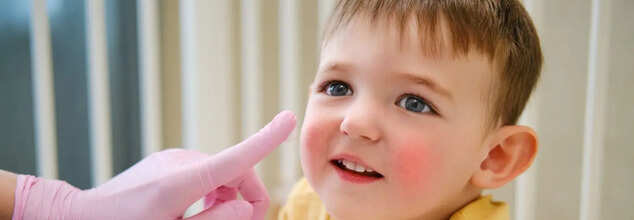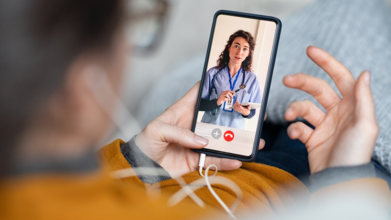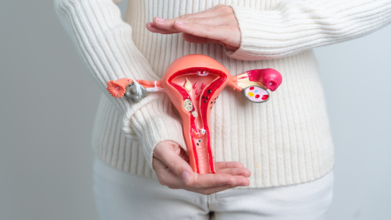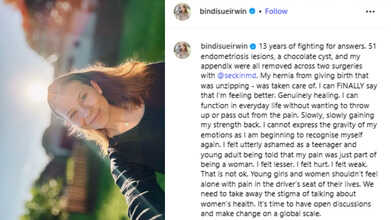- Health Conditions A-Z
- Health & Wellness
- Nutrition
- Fitness
- Health News
- Ayurveda
- Videos
- Medicine A-Z
- Parenting
- Web Stories
Dead Sea Salt May Soothe Eczema: How To Use It

Credit: Canva
While salts have been known to mitigate its effect, researchers have said that the Dead Sea in particular is effective in soothing eczema.
Eczema is a common skin condition that causes red or discoloured, itchy patches of skin. It is a type of dermatitis that breaks your skin's barrier functions, which are responsible for helping it retain moisture and protect your body from outside elements. While it can affect people of any age, children are more at risk.
What Is Dead Sea Salt?
As the name suggests, dead sea salt refers to salt and other mineral deposits collected from the Dead Sea. It is rich in nutrients because sea salt products are minimally processed and are made from evaporated seawater. It is the minerals in this water that make it effective on skin conditions.
While salts have been known to mitigate its effect, researchers have said that the Dead Sea in particular is effective in soothing eczema. Dead Sea salt, unlike regular table salt or Epsom salt, is rich with nutrients like magnesium, calcium, sulfur and zinc.
A study in 2005 concluded that soaking in a bath with salt from the Dead Sea can improve your skin's barrier strength, compared with a tap-water soak. This study found that topical treatments with Dead Sea salt improved moisture in the skin. After the sea salt bath, the salt also reduced: inflammation.
How To Use Dead Sea Salt For Eczema
Dry skin makes eczema more severe, so treatments that can replace moisture in the skin are recommended. The National Eczema Association (NEA) suggests a warm bath followed by a moisturizer to help replace some of that moisture. You can follow these steps when using a salt soak:
Follow the directions on the salt product you buy to get the right solution. Typically, 1 to 2 cups of salt are used per bath.
Pour a warm, not hot, water bath. Pour the salt product into the bath before you soak.
Soak for 5 to 10 minutes. Soaking too long can make dry skin worse. Hot water can also irritate and dry out skin.
Use a cleanser designed for sensitive skin. Most are free of dyes, fragrances, or exfoliating ingredients.
Gently wash your skin, and rinse off cleansers.
Use a towel to pat dry, not rub, your skin. This may leave your skin slightly damp.
Apply any prescription topical medications to your skin.
Use an approved moisturizing lotion all over your body within 3 minutes of getting out of your bath. The best lotions for people with eczema are ones with a high oil content but no fragrances or dyes.
Give your skin several more minutes to fully absorb the medications and moisturizer before getting dressed.
What Causes Eczema?
Eczema flares up when your skin comes into contact with substances that irritate it, such as smoke, small bugs in dust, or harsh chemicals. This overburdens your immune system. Some people may be prone to eczema due to genetic factors. It implies individuals are born with certain genes that influence how well their skin protects them. When the skin's defence is weak, it can't retain moisture and protect against bacteria, allergens, and other environmental factors.
- Consult a skin specialist or dermatologist, if you see these symptoms:
- Ingredients in cleaners and detergents
- Things that have a strong odour
- Cigarette smoke
- Things from the outside, such as pollen, mould, dust, or tiny creatures in dust
- Wool and other scratchy fabrics
- Fabrics that are not real
- Sweating
- Temperature shifts
- Stress
- Specific food allergies
- Pet hair
- Infections in your upper respiratory system
Deepfake Doctor Videos Are Pushing False Medical Advice, How Can You Identify Medical Misinformation

(Credit - Canva)
As soon as people became aware of AI videos and pictures, one of the first things people were concerned about was how this can fake videos of people and cause trouble. Concerns about manipulative videos that can tarnish a person’s identity, revenge porn and many other issues were raised. Although many people remained steadfast in their belief that they would be able to recognize AI videos or pictures, other pointed out how it won’t be long before we start to no longer distinguish between the two. That time is not far off, in fact we may have already hit another roadblock, misinformation.
Dr. Joel Bervell, a well-known physician on social media, recently discovered a deepfake video using his likeness to promote a product. The video featured his face but a different voice, and was posted on several platforms, including TikTok, Instagram, Facebook, and YouTube.
A CBS News investigation found more than 100 videos across social media featuring fake doctors. Some of these videos used the identities of real physicians to give medical advice or sell products, mostly related to beauty, wellness, and weight loss. Many of these videos were viewed millions of times. Cybersecurity company ESET also found over 20 similar accounts, noting that this type of content is reaching an increasingly wide audience.
What Are These Deepfake Videos On Social Media?
Deepfakes are duped videos or audios that are made with AI. This isn’t simple face swapping or editing, it is basically manipulating the media files to make it look like an individual is doing certain things or say something they never did. Reports of fake videos to TikTok, Meta (the parent company of Instagram), and YouTube. Both TikTok and Meta removed the flagged videos, stating they violated company policies. TikTok says it has proactively removed over 94% of content that violates its AI policies.
YouTube, however, said the videos did not violate its Community Guidelines and would remain on the platform. The company stated its policies prohibit content that spreads medical misinformation contradicting local health authority guidance, but did not find the flagged videos to be in violation. Meta also noted that scammers are always changing their tactics to get around platform rules.

How Can You Spot Deepfakes?
According to Illinois State University identifying deepfakes can be difficult. Here are some things that could reveal whether a media file is deepfake or not.
Skin
Look at the cheeks and forehead. Does the skin look too smooth or too wrinkled? Does it match the person's age? Sometimes, deepfakes don't get these details right.
Eyes and Eyebrows
Check for natural shadows. Deepfakes can fail to correctly show how light and shadows work, making things look unnatural.
Facial Hair
Does a beard, mustache, or sideburns look real? Deepfakes can add or remove facial hair, but it might not look completely natural.
Blinking and Lips
Watch how the person blinks. Do they blink too much or not enough? Also, look at their lips. Do they match the size and color of the rest of their face? Deepfakes can often mess up these small details.
Glasses
Look for glare on their glasses. Is there too much glare? Does the glare change in a realistic way when they move? Fake videos often get this wrong.
Moles
If the person has a mole or other facial marks, do they look real? Deepfakes might not recreate them accurately.
How Can You Identify Medical Misinformation?
Before you can fight misinformation, you need to be able to recognize it. Here are some key things to check when you're looking at information online:
Check the Source
Look for a "Contact Us" or "About Us" page on the website. Is the website from a trustworthy place, like a university (.edu) or government (.gov)? What are the author's qualifications, and have they written other things? Also, consider who shared the information with you—are they a reliable source, like a healthcare professional?
Read Past the Headline
Headlines are often written to grab your attention. Make sure the actual article backs up the headline's claims. Watch out for authors who only use certain facts or take information out of context.
Examine the Evidence
Credible articles will back up their claims with facts and sources. If a story has no sources, that's a red flag. If it does, check them to see if you come to the same conclusions.
Check the Date
Sometimes people share old information that is no longer correct. Make sure the information is recent and relevant.
Be Aware of Your Own Biases
Think about your own beliefs. Are you looking at the information objectively, or just looking for things that agree with what you already think?
Look for Satire
If something sounds too outrageous to be true, it might be a joke. Some websites create funny, fake news stories for entertainment. If you are unsure, ask a doctor, scientist, or even a librarian for help. You can also use reliable fact-checking websites to see if something is true.
Bindi Irwin's Endometriosis Journey 'After 51 Lesions, Chocolate Cyst, 2 Surgeries And Hernia... I'm Finally Feeling Better’

(Credit - Bindi Irwin/Instagram)
Australian TV star Bindi Irwin, famous as the daughter of the "Crocodile Hunter" Steve Irwin, is speaking out about her long and painful battle with endometriosis. After a decade of suffering, she recently shared that she is "genuinely healing" after undergoing surgery to remove 51 lesions, a cyst, and her appendix. The 27-year-old said she is "slowly gaining my strength back" and "beginning to recognize myself again."
What Is Endometriosis?
Endometriosis is a condition where tissue similar to the lining of the womb grows outside of it, often in places like the ovaries and fallopian tubes. This can lead to severe pain during periods, sexual intercourse, and bowel movements, along with bloating, nausea, and extreme tiredness. About one in ten women have this condition, yet it is often misunderstood.
Irwin's story has brought a lot of attention to the issue. She shared that for years, she was told her pain was "just part of being a woman," which made her feel "ashamed" and "weak." Now, she is pushing for a change, writing on Instagram, "We need to take away the stigma of talking about women's health. It's time to have open discussions and make change on a global scale."

What Is Chocolate Cyst?
The Cleveland Clinic explains that when the endometriosis tissue attaches to an ovary, it can form a type of cyst called an endometrioma. These cysts are often filled with a thick, brownish fluid, which is why they are sometimes called "chocolate cysts." An endometrioma can be a sign that a person has a more severe form of endometriosis.
The most common symptom of endometrioma is pelvic pain, which can happen at any time, not just during a period. Other symptoms can include:
- Very painful periods.
- Pain during sex.
- Pain when using the bathroom.
- Feeling the need to pee more often.
- Back pain.
- Nausea, vomiting, and bloating.

Endometriomas can be very small or grow quite large, affecting one or both ovaries. It's not clear what exactly causes them, but one popular theory is retrograde menstruation. This is when some of the tissue shed during a period flows backward through the fallopian tubes and attaches to the ovaries. This tissue then thickens and bleeds with each menstrual cycle, causing inflammation and forming the cyst. About 10% of people who get periods have endometriosis, and a significant portion of them—between 17% and 44%—will develop endometriomas.
If an endometrioma is causing pain, is large, or is affecting a person's ability to get pregnant, there are treatments available to help.
Why Do Endometriosis Diagnosis Take Years?
In March of 2023, Bindi shared her decade-long struggle with endometriosis, a painful condition that left her with constant fatigue, pain, and nausea. She decided to go public with her story to help other women who might be suffering in silence.
However, this is not an isolated incident, many women go through years of pain. According to 2024 British Journal of Obstetrics and Gynaecology study reviewed 17 different publications. It found that the time it takes to get a diagnosis for endometriosis can range from just a few months to 12 years. This long wait depends on where a person lives and their specific health issues.
The main conclusion is that a long wait for a diagnosis is still a major problem. The study suggests this delay is mostly due to doctors and a lack of clear understanding of the disease.
Bindi ended her post saying women and girls should not feel ashamed of their pain, “We need to take away the stigma of talking about women’s health. It’s time to have open discussions and make change on a global scale.”
Yes! Cats Have Dementia, And They Could Be The Key To Dementia Care For Humans

(Credit - Canva)
A new study from the University of Edinburgh found that the brains of cats with dementia show changes very similar to those seen in humans with Alzheimer's disease. These findings are a big step forward and could lead to new treatments for both people and pets. For the first time, researchers can see how the brains of cats naturally change as they get older and develop dementia, which provides a much more realistic picture of the disease than previous research has been able to. This discovery is a huge breakthrough because it offers a new way to study the disease and find better treatments.
How Can Cats Help Us Treat Dementia?
In the past, scientists have relied on genetically modified rodents to study Alzheimer's. However, rodents do not naturally get dementia. Cats, on the other hand, do. They also show similar symptoms to humans, such as confusion and changes in sleep patterns. Because of these similarities, cats provide a more accurate and natural model for studying the disease.
Dr. Robert McGeachan, the study's lead researcher, said that because cats naturally develop these brain changes, they may help scientists explore whether promising new treatments for human Alzheimer’s could also help our aging pets. This research benefits both species and their caregivers.

What Does Cat Dementia Reveal About Humans?
Scientists at the University of Edinburgh examined the brains of 25 cats after they passed away. They found that older cats and those with dementia had a build-up of a toxic protein called amyloid-beta. This protein is a key sign of Alzheimer’s disease.
The research showed that this protein was found in the synapses—the connections between brain cells. These connections are essential for healthy brain function. When they are lost, a person's memory and thinking skills decline.
The research also discovered that some support cells in the cats' brains were "eating" these damaged synapses. This process, known as synaptic pruning, is a normal part of brain development but can contribute to the loss of synapses in dementia.
Why Is Dementia On The Rise?
Dementia is a very common disease among older people, and since the elderly population is growing quickly worldwide, the number of people living with dementia is expected to increase. A study published in the Journal of the Neurological Sciences journal, based in Wales, UK, looked at medical records from 1999 to 2018 to understand this trend. The study included over 161,000 dementia diagnoses from nearly 117,000 people. The study found a few important things:
Older Age at Diagnosis
The average age for a dementia diagnosis has been going up. This means fewer younger people are being diagnosed with the disease.
More Cases and Longer Lives
The number of new dementia cases has risen and so has the total number of people living with the disease. The study also found that people with dementia are living longer than they used to, even with their diagnosis.
This is not just limited to the UK, dementia cases in the US are also estimated to double by 2060. Published in the journal Nature Medicine, followed nearly 16,000 Americans since 1987, found that the overall lifetime risk for developing dementia for a middle-aged American is 42 percent.
This risk is higher for women (48 percent) than for men (35 percent), mainly because women tend to live longer. The risk also increases with age, rising to over 50 percent for people who live to be 75. The study's authors believe that previous estimates were too low because of poor record-keeping and a lack of data on early-stage cases and racial minorities.
According to the study, preventing heart diseases like high blood pressure and diabetes can also help slow cognitive decline and prevent dementia. Other factors linked to a higher risk include obesity, unhealthy diets, lack of exercise, and poor mental health.
© 2024 Bennett, Coleman & Company Limited

